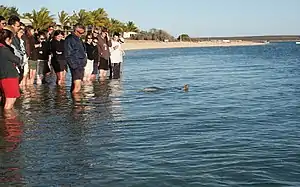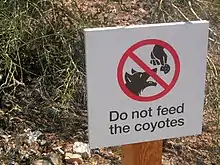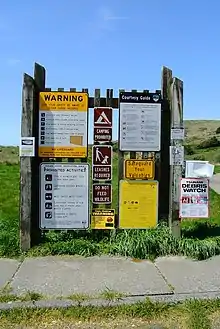Do not feed the animals
The prohibition "do not feed the animals" reflects a policy forbidding the artificial feeding of wild or feral animals. Signs displaying this message are commonly found in zoos, circuses, animal theme parks, aquariums, national parks, parks, public spaces, farms, and other places where people come into contact with wildlife.[4][5][6] In some cases there are laws to enforce such no-feeding policies.[7][8]

.jpg.webp)

Feeding wild animals can significantly change their behavior. Feeding or leaving unattended food to large animals, such as bears, can lead them to aggressively seek out food from people, sometimes resulting in injury.[9] Feeding can also alter animal behavior so that animals routinely travel in larger groups, which can make disease transmission between animals more likely.[10] In public spaces, the congregation of animals caused by feeding can result in them being considered pests.[11] In zoos, giving food to the animals is discouraged due to the strict dietary controls in place.[5] More generally, artificial feeding can result in, for example, vitamin deficiencies[12] and dietary mineral deficiencies.[13] Outside zoos, a concern is that the increase in local concentrated wildlife population due to artificial feeding can promote the transfer of disease among animals or between animals and humans.[12][14]
Sign example gallery
 Signs such as this are used to emphasize a no-feeding policy
Signs such as this are used to emphasize a no-feeding policy Signs in Australia discouraging locals against feeding urban wildlife
Signs in Australia discouraging locals against feeding urban wildlife
 Sign in Singapore telling people not to feed the pigeons
Sign in Singapore telling people not to feed the pigeons Sign telling citizens to not feed the ducks[16]
Sign telling citizens to not feed the ducks[16] Prohibited activities and safety instructions at a state park in Oregon
Prohibited activities and safety instructions at a state park in Oregon
Zoos
Zoos generally discourage visitors from giving any food to the animals.[5] Some zoos, particularly petting zoos, do the opposite and actively encourage people to get involved with the feeding of the animals.[17] This, however, is strictly monitored and usually involves set food available from the zookeepers or vending machines, as well as a careful choice of which animals to feed, and the provision of hand-washing facilities to avoid spreading disease.[2] Domestic animals such as sheep and goats are often permitted to be fed,[2] as are giraffes.[17]
National and state parks
In national parks and state parks, feeding animals can result in malnourishment due to inappropriate diet and in disruption of natural hunting or food-gathering behavior. It can also be dangerous to the people doing the feeding.[18]
In the US, early 20th century park management actually encouraged animal feeding. For example, "the feeding of squirrels had been seen as a way to civilize the parks and rechannel the energies of young boys from aggression and vandalism toward compassion and charity."[19] Park rangers once fed bears in front of crowds of tourists.[20] However, with a greater awareness of ecological and other issues, such pro-feeding policies are now viewed as detrimental,[1][19][20][21] and US national parks now actively discourage animal feeding.[22]
In Canadian national parks, it is illegal to disturb or feed wildlife,[23] and Parks Canada advises visitors not to leave out "food attractants" such as dirty dishes.[24] Ironically, the "it is unlawful to feed animals" signs may themselves become food attractants for porcupines.[25] Road salt and roadkill may also act as food attractants, and removing roadkill is considered good park management.[26]
Marine parks
Tourism operators often provide food to attract marine wildlife such as sharks to areas where they can be more easily viewed. Such a practice is controversial, however, because it can create a dependency on artificial feeding, habituate animals to feeding locations, increase inter-species and intra-species aggression, and increase the spread of disease.[27] In Australia's Great Barrier Reef Marine Park, shark feeding is prohibited.[28] In Hawaiian waters, shark feeding is permitted only in connection with traditional Hawaiian cultural or religious activities.[29]
The feeding of wild dolphins for tourist purposes is also controversial, and is prohibited in the US because it can alter natural hunting behaviour, disrupt social interaction, encourage the dolphins to approach or ingest dangerous objects, and endanger the person doing the feeding.[30][31] At Monkey Mia in Western Australia, dolphin feeding is permitted under Department of Environment and Conservation supervision.[3]
Backyards
Similar issues to those in national and state parks also apply in suburban and rural backyards. Artificial feeding of coyotes, deer, and other wildlife is discouraged.[9][15][32] Feeding deer, for example, may contribute to the spread of bovine tuberculosis.[13] The feeding of birds with bird feeders is an exception, at least in the US, even though it can sometimes contribute to spreading disease.[32][33][34] In Australia, artificial bird feeding is viewed more negatively.[12] Instead, growing native plants that can act as a natural food source for birds is recommended.[12] Similar suggestions have been made in the US.[13]
Public spaces
Feral pigeons are often found in urban public spaces. They are often considered environmental pests, and can transmit diseases such as psittacosis.[11] Deliberate feeding of feral pigeons, though popular, contributes to these problems.[11]
Ducks are also commonly fed in public spaces. In an early 1970s US study, 67% of people visiting urban parks did so to feed ducks.[35] However, such feeding may contribute to water pollution and to over-population of the birds, as well as delaying winter migration to an extent that may be dangerous for the birds.[16] Feeding foods such as white bread to ducks and geese can result in bone deformities.[13] Like pigeons, ducks may also congregate in large numbers where feeding takes place, resulting in aggression towards humans who don't have food to hand as well as towards other individuals in the group. Ducks can also be messy animals, and the cleanup of an area where they congregate is time consuming.
Traditions of feeding the animals
Some people oppose such laws claiming that animals such as pigeons can be an amenity for people who do not have company such as friends or family, and say that the laws prohibiting feeding animals in urban places must change.[36] In some countries, such as Greece, feeding the pigeons in cities is a widespread practice.[37] Cultural hostility to feeding animals in cities and laws that ban the practice raise concerns about how humans relate to other living beings in the urban environment.[38] In some areas, feeding animals in a sustainable manner has been encouraged, as without supplementation of food from humans in addition to their natural supply, some animals, especially waterfowl such as ducks, geese and swans, have become malnourished and underweight.[39][40]
Politicians have also protested laws that ban feeding feral pigeons in cities.[38] Feral pigeons in cities existed for thousands of years but only recently in some countries humans started seeing them as a nuisance and became hostile to them.[41] In India, feeding feral animals in cities is considered a noble act.[42] Academicians say that how humans treat animals is related to how humans treat each other and thus raise concerns about the cultural shift from seeing feral city pigeons as harmless in the 1800s to seeing them an undesirable in some countries in the 2000s.[41]
See also
References
- Tammy Lau and Linda Sitterding, Yosemite National Park in Vintage Postcards, Arcadia Publishing, 2000, p. 125. Archived 2013-11-02 at the Wayback Machine
- Paul A. Rees, An Introduction to Zoo Biology and Management, Wiley, 2011, p. 306. Archived 2020-06-13 at the Wayback Machine
- Shire of Shark Bay. "Monkey Mia Reserve". Archived from the original on 2013-10-05. Retrieved 2013-09-29.
- Nigel Rothfels, Savages and Beasts: The Birth of the Modern Zoo, JHU Press, 2008, ISBN 0801898099, p. 35.
- Darill Clements, Postcards from the Zoo, HarperCollins Australia, 2010.
- Dwyer, June (2013). "Do Not Feed the Animals: Do Not Touch: Desire for Wild Animal Companionship in the Twenty-first Century". Interdisciplinary Studies in Literature and Environment. 19 (4): 623–644. doi:10.1093/isle/iss118.
- NOAA Public Affairs, DO NOT FEED OR INTERACT WITH HAWAIIAN MONK SEALS Archived 2005-11-05 at the Wayback Machine, 30 January 2004, accessed 24 June 2013.
- Montana Fish, Wildlife and Parks (January 29, 2013). "Artificial Feeding of Wildlife is against the law". State of Montana. Archived from the original on 2013-04-29. Retrieved 2013-06-30.
- Stanley D. Gehrt, Seth P. D. Riley, and Brian L. Cypher, Urban Carnivores: Ecology, Conflict, and Conservation, JHU Press, 2010, ISBN 0801893895, p. 231. Archived 2013-10-11 at the Wayback Machine
- Frederick R. Adler and Colby J. Tanner, Urban Ecosystems: Ecological Principles for the Built Environment, Cambridge University Press, 2013, ISBN 0521769841, p. 210. Archived 2017-02-22 at the Wayback Machine
- C. Philip Wheater, Urban Habitats, Routledge, 2002, ISBN 0203061144, p. 94. Archived 2020-06-13 at the Wayback Machine
- "Feeding native animals". Queensland Government. 2011. Archived from the original on 2013-04-21. Retrieved 2013-06-30.
- Carol A. Heiser. "Feeding Wildlife: Food for Thought" (PDF). Virginia Department of Game and Inland Fisheries. Archived from the original (PDF) on 2013-05-21. Retrieved 2013-07-06.
- Alex Cukan (August 31, 2002). "'Do not feed wild animals'". UPI Science News. Archived from the original on 2014-05-20. Retrieved 2013-06-29.
- "Coyote Attacks: An Increasing Suburban Problem" (PDF). Archived from the original (PDF) on September 26, 2007. Retrieved August 19, 2007.
- Laura Erickson, 101 Ways to Help Birds, Stackpole Books, 2006, ISBN 0811733025, p 130. Archived 2020-06-10 at the Wayback Machine
- Devra G. Kleiman, Katerina V. Thompson, and Charlotte Kirk Baer, Wild Mammals in Captivity: Principles and Techniques for Zoo Management, 2nd ed., University of Chicago Press, 2010, ISBN 0226440117, p. 140. Archived 2020-06-11 at the Wayback Machine
- Evans, Lisa Gollin (2011). Outdoor Family Guide: Rocky Mountain National Park. The Mountaineers Books. p. 23. ISBN 9781594854996. Archived from the original on 2013-11-01. Retrieved 2016-09-22.
- Benson, Etienne (December 2013). "The Urbanization of the Eastern Gray Squirrel in the United States". Journal of American History. 100 (3): 691–710. doi:10.1093/jahist/jat353.
- Robert B. Keiter, To Conserve Unimpaired: The Evolution of the National Park Idea, Island Press, 2013, p. 176. Archived 2013-11-27 at the Wayback Machine
- Robert W. Sandford, Ecology and Wonder in the Canadian Rocky Mountain Parks World Heritage Site, Athabasca University Press, 2009, pp. 284–288. Archived 2013-11-02 at the Wayback Machine
- David Williams, "Conspicuous Consumption," National Parks, April/May 2002, pp. 40–45.
- Terry Inigo-Jones, The Canadian Rockies Colourguide, James Lorimer, 2010, p. 54. Archived 2013-10-11 at the Wayback Machine
- Parks Canada. "Jasper National Park: Safety and Hazards". Archived from the original on 2013-09-25. Retrieved 2013-09-29.
- Kevin Van Tighem, Wild Animals of Western Canada, Rocky Mountain Books, 2009, p. 32. Archived 2013-10-28 at the Wayback Machine
- Jon P. Beckmann, Anthony P. Clevenger, Marcel Huijser, and Jodi A. Hilty, Safe Passages: Highways, Wildlife, and Habitat Connectivity, Island Press, 2010, p. 68. Archived 2013-10-11 at the Wayback Machine
- Higham, James; Lück, Michael (2008). Marine Wildlife and Tourism Management: Insights from the Natural and Social Sciences. CAB International. p. 58. ISBN 978-1-84593-345-6. Archived from the original on 2020-06-22. Retrieved 2016-09-22.
- Great Barrier Reef Marine Park Authority. "Environmental Status: Sharks and rays: Response: tourism". Archived from the original on 2011-04-11. Retrieved 2013-07-10.
- Hawaii Department of Land and Natural Resources, Hawaii Department of Agriculture. "Prohibition of Shark Feeding". Archived from the original on 2014-08-20. Retrieved 2013-07-10.
- Gales, Nicholas; Hindell, Mark; Kirkwood, Roger (2003). Marine Mammals: Fisheries, Tourism and Management Issues. CSIRO. p. 306. ISBN 0643099263. Archived from the original on 2013-11-05. Retrieved 2016-09-22.
- National Marine Fisheries Service. "Protect Dolphins Campaign". Archived from the original on 2013-02-25. Retrieved 2013-07-19.
- Stephen DeStefano, Coyote at the Kitchen Door: Living With Wildlife in Suburbia, Harvard University Press, 2010, p. 76.
- Tom Warhol and Marcus Schneck, Birdwatcher's Daily Companion: 365 Days of Advice, Insight, and Information for Enthusiastic Birders, Quarry Books, 2010, p. 7. Archived 2013-10-11 at the Wayback Machine
- Fitzpatrick, John W.; Dhondt, André A. (c. 2003). "In Defense of Bird Feeding". Cornell Lab of Ornithology. Archived from the original on 17 June 2014. Retrieved 7 March 2022.
- Thomas G. Barnes, Gardening for the Birds, University Press of Kentucky, 1999, ISBN 0813129028, p. 9. Archived 2020-06-22 at the Wayback Machine
- "Lonely woman must pay £2,300 for refusing to stop feeding pigeons". Daily Mirror. 23 February 2016. Archived from the original on 6 March 2018. Retrieved 5 April 2018.
- Feeding pigeons in Athens Greece Syntagma Tomb Of Unknown Soldier .wmv. YouTube. Archived from the original on 2021-12-11.
- "unpleasant for pigeons". un·pleas·ant de·sign·. Archived from the original on 2016-09-21. Retrieved 2017-01-10.
- "Don't stop feeding the swans". www.henleystandard.co.uk. Archived from the original on 2021-12-26. Retrieved 2021-12-26.
- Beck, Samantha (2019-10-18). "Charities calling on people to feed bread to ducks and swans again". ChronicleLive. Archived from the original on 2021-12-26. Retrieved 2021-12-26.
- Jerolmack, Colin. "How Pigeons Became Rats: The Cultural-Spatial Logic of ProblemAnimals" (PDF). NYU. Archived from the original (PDF) on 17 April 2012.
- "Why feed pigeons, dogs or monkeys in public places". 13 June 2016. Archived from the original on 10 January 2017. Retrieved 10 January 2017.
.jpg.webp)